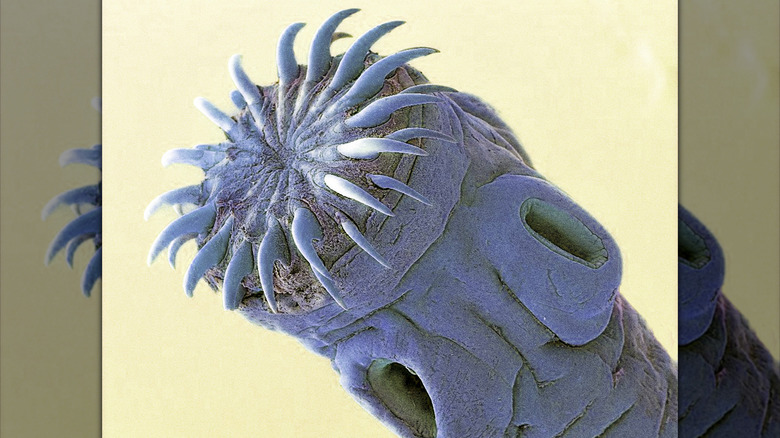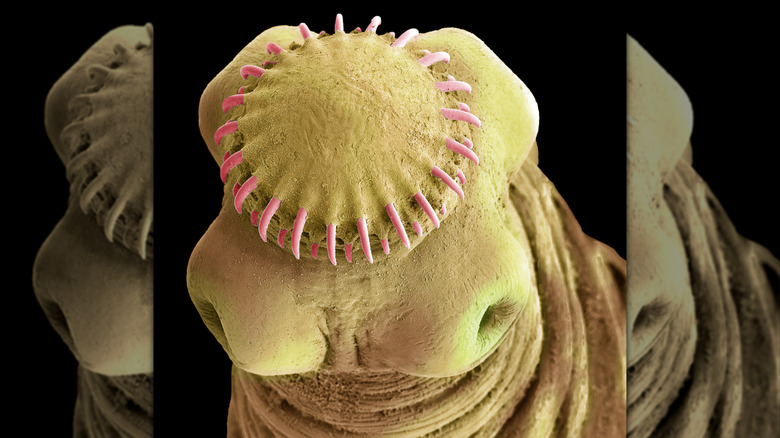What Tapeworms Look Like Under A Microscope Puts Horror Movie Monsters To Shame
There are lots of uses for a microscope, but using them to get a closer look at small creatures such as insects can be truly startling especially for those that don't seem all that strange in day-to-day life. Ants, for example, are so tiny we often don't think about how they might look in closeup, but putting one under a microscope quickly reveals a truly unsettling alien physiology, especially when it comes to their heads, which look more like some sort of orc than the head of an insect.
But there are some species that don't need to be viewed under a microscope in order to induce feelings of revulsion. Tapeworms, for instance. These parasitic flatworms already don't have the best reputation, due to, well, their parasitic nature and general proclivity for living inside human intestines. Making things worse in that respect is the fact that tapeworms, which infect human beings, often don't produce any symptoms in the host, meaning if we're ever unlucky enough to have a tapeworm in our guts, we might never even know about it. All of which is to say that a parasitic worm that can secretly live in our body doesn't exactly need anything else to add to its array of unpleasant attributes. But, just in case you did need another reason to be repulsed by tapeworms, looking at one in close-up under a microscope is as horrific an experience as you might expect.
Tapeworm heads look otherworldly in closeup
Cestodes, as tapeworms are known collectively, are ribbon-shaped segmented worms, with each segment containing both a male and female reproductive system. Tapeworms are made up of three parts: the scolex (head), neck, and strobila (body). Since they don't actually don't have a digestive tract of their own, they instead have to absorb nutrients from their host's small intestine. To do so, the creatures attach themselves to the walls of the intestines using hooks on their scolex. Perhaps even more upsetting are the suckers, which surround the scolex and use crisscrossing fibers in their inner surfaces to contract and attach to surfaces.
What might such an insidious-sounding head look like under a microscope? Not very nice, as it happens. One extreme closeup from 2017 reveals the scolex of a Taenia solium tapeworm, and it's just as upsetting as you might imagine. Taken by Teresa Zgoda at the Rochester Institute of Technology, the photo uses a confocal technique to display a detailed image of the tapeworm scolex at 200 times magnification. The shot won 4th place at the Nikon 2017 Microphotography competition, though it was surely for the effort involved rather than the frightening beast it revealed.
Tapeworms are some of the most disturbing parasites
In total, there are around 5,000 species of Cestodae. Yes, there are thousands of species of tapeworm, though if it's any consolation, there are only a handful which affect humans. On the plus side, tapeworms don't always cause disease, and infected humans are often asymptomatic. But that doesn't mean the parasites never cause disease.
Tapeworms actually have three life cycles, the adult stage, larval stage, and egg stage, and depending on which form infects a host, they can result in different symptoms. Adult tapeworms in humans can cause a number of issues, from anorexia to nausea and diarrhea. Certain types of larval tapeworms, on the other hand, may lie dormant in large cysts (a condition known as cysticercosis) which can form in the brain, eyes, muscles, liver, lungs, or other organs — and to think tapeworms were actually used as a crazy medical treatment in the past.
Adding to the tapeworm's general disgust level is the fact that the largest genus to infect humans is Diphyllobothrium, which can grow from 6.5 feet to almost 60 feet in length. The largest tapeworm ever recorded wasn't found in a human, however, and was in fact a giant 131-foot Tetragonoporus calyptocephalus — a type of tapeworm that lives deep inside the intestines of whales. With all that in mind, it's not actually surprising that tapeworms look downright disturbing in a way that puts horror movie monsters to shame.


